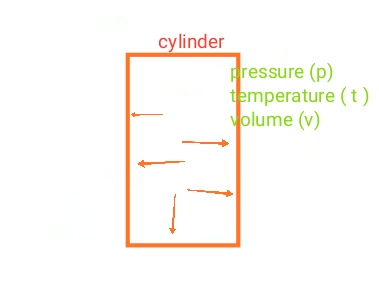Thermodynamics -
Thermodynamics is the branch of science that deals with the study of thermal properties of the material present around us.
Thermodynamics is the branch of the science that deals with the relationship between the energy and the materials. There are various laws that govern the transformation of energy. Zeroth law is one of them. Thermodynamics is the study of the laws that causes the change in the state of physical system of the material.
The part of the space that we are going to investigate that is known a system. The part of the space beyond the system that is not under the investigation that is known as the surrounding. The line that separates the system and the surrounding that is known as boundary. .
Types of System -
I) Closed System
A system that is enclosed by a boundary and we cannot exchange the mass between the system and the surrounding, then the system is known as closed system.
ii) Open System
The system that is not inclosed by the boundary and we can exchange the mass and the energy between the system and the surrounding, then it is known as open system. The open system is a system that can lose its energy. A glass full of hot tea and hot water gets colder after sometime. This is the example of the open system.
iii) Isolated System
A system that is fully closed by boundary and there is no exchange of mass between the system and the boundary, then it is known as isolated system.
Zeroth Law of thermodynamics -
Zeroth Law explains that how system can get the thermal equilibrium. When one system is under thermal equilibrium with second system, and second system is under thermal equilibrium with the third system, then according to this law first system is under thermal equilibrium with the third system.
First law of Thermodynamics -
First law of thermodynamics states that the heat transfer is equal to the net work done, in case of a closed system, while going under through the Thermodynamics cycle.
It also illustrates that when we are in Thermodynamics cycle, then the work transfer is equal to the heat transfer. The most important condition for this is that the system must be the closed system. it can be taken as in other words such as the system cannot create and cannot not destroye the heat energy.
The energy cannot be created neither can be destroyed, while changing the state of the system in Thermodynamics cycle. There are various limitations of the first law of thermodynamics . Heat energy cannot be fully transformed into the mechanical energy. There are various applications of the first law of thermodynamics. The steady flow of the nozzle and diffuser can be explained using the first law of the thermodynamics. In case of steady flow process, the heat transfer and the work done are constant or they are stable.
Second law of Thermodynamics -
The second law of thermodynamics illustrates that the heat cannot transfer by itself from the lower temperature region to the higher temperature region.
The heat can transfer from the high-temperature region to the lower temperature region easily, but in case of lower temperature region, there should be some external force to help it. This law is also known as Clausius statement, in which the work is done by only when the heat transfer from the lower temperature region to the higher temperature region. The work is done, when the heat is transferred from the lower temperature region to the higher temperature region. Second law of the thermodynamics enables us to divide the process in the two parts, first one is the reversible process and the second one is the Irreversible process. In case of reversible process, the process can automatically reverse itself to its original shape or the original condition. In case of Irreversible process, the process cannot repeat itself or reverse itself automatically.
Quasi - static process -
Quasi- static process is the example of the reversible process. It is also known as the reversible process because there is very less deviation of its equilibrium position. All the states of the system may go through the change. The change in the state of equilibrium, is very negligible here, so it may be known as the reversible process.
Thermodynamics deals with the study of the initial and the final state of the system while undergoing to the various changes. Law of thermodynamics can be applied only when the system undergoes from one equilibrium to the another equilibrium or the system is already present in the state of equilibrium. In case of study of thermodynamics, the function or the variable that can affect the state of the equilibrium of the system, are known as the state variable. The example of these state variables are pressure, energy, heat, mass and work.
It is known to all that the heat is the energy transferred through the system at some temperature difference. The internal energy is the sum of potential energy well as kinetic energy. It is the state function because it depends on the state, it does not depend on the path through which it passes. The internal energy is the example of state function. The work done is generally calculated by the integration of product of pressure and a change of volume. The work done is the example of the path function because it depends on the path of the process.
The heat is the combination of the internal energy and the work done by the system. When the heat is added to the system, then it is taken as the positive heat. If it is taken out from the system, then it is known as the negative heat. If the internal energy increases in the system then it is taken as the positive energy. If energy is expelled from system, then it is taken as the negative internal energy.
Numerical -. A cylinder of oxygen is having internal pressure of 100 atm. At 30 degree Celsius, oxygen is stored in the cylinder which exerts pressure of 22 atm. At which temperature does the danger of explosion will sets in ?
Solution
Pressure of cylinder at the first state = P1
P1. = 100 atm
temperature = T1
Volume = V (volume is contant)
Pressure of cylinder at the second state = P2 = 22 atm
temperature = T2 = 303 Kelvin
Volume = V (volume is contant)
PV =n RT
For first state,
( P1) (V )=n R (T1) _____________________(1)
For second state,
(P2)(V )=n R (T2) ______________________(2)
Dividing equation (1) by equation (2)
( P1) (V ) / (P2)(V ). = n R (T1) / n R (T2)
(P1) / (P2) =. (T1) / (T2)
100/22 = (T1) / 303
(T1) = 1377 Kelvin (ans)
State variable -
The state variables are the variables which can explain or illustrate very clearly about the Thermodynamics system undergoing to the various changes of the states.
Examples of state variable are pressure, temperature and the volume. There are two types of variables - intensive and extensive variables.
Intensive variables
Intensive variables are the variables which are independent of the size of the system. The example of the intensive properties or intensive variables are pressure, temperature and density.
Extensive variables -
The extensive property or the variable are the variables which are dependent of the size of the system. The example of the extensive variables are mass, volume and number of moles. If we multiply the extensive and intensive variables, then the product will be the extensive variable. For example, if we multiply temperature with the volume, the product will be having the extensive properties. So, here the product is the extensive variable.
Thermodynamics process -
The process by which thermodynamic cycle or thermodynamics system is taken from one state to another state, is called thermodynamic process.
Isothermal process -
If thermodynamics system undergoes through the various changes and it change its state from one state to another state, then there will be some changes in their temperature or their pressure. If the temperature of both states remains constant, then the process is known as the isothermal process.
Isobaric process -
If the pressure of both, the first state and the second states remains constant, then the process is known as isobaric process.
Isochoric process -
If the volume of the first state and the second stage remains constant or unchanged, then the process is known as Isochoric process.

 Create and manage your profile
Create and manage your profile Refer an author and get bonus Learn more
Refer an author and get bonus Learn more Publish any lost and found belongings
Publish any lost and found belongings Connect with the authors & add your review comments
Connect with the authors & add your review comments Join us for Free to advertise for your business or
Contact-us for more details
Join us for Free to advertise for your business or
Contact-us for more details
 Join us for Free to publish your own blogs, articles or tutorials and get your
Benefits
Join us for Free to publish your own blogs, articles or tutorials and get your
Benefits


 1 like
1 like


